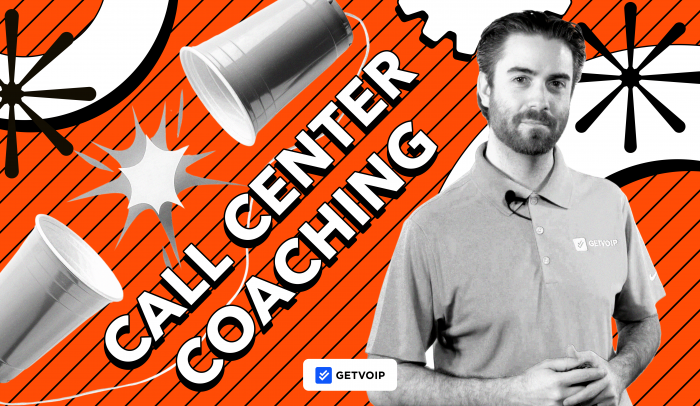Call center coaching is an essential part of the agent onboarding process, but providing ongoing agent training and regular performance feedback is equally important. Effective call center agent coaching clarifies performance expectations, creates a consistent customer experience, and improves CSAT scores.
Coaching tools help call center managers identify agent strengths and weaknesses, evaluate the effectiveness of current training materials, and increase employee engagement and retention rates. Ongoing agent training, especially when coupled with real-time call center activity monitoring and call recording, uncovers insights that streamline the customer journey, improve the agent scheduling process, and increase first contact resolution rates.
This post outlines different agent coaching strategies and tools, highlights potential challenges in the coaching process and their solutions, and includes actionable tips and tricks to optimize agent training at your call center.
- Overview
- Benefits
- Strategies
- Types of Coaching
- Measuring ROI
- Common Challenges
- Best Practices
- Best Tools
- FAQs
What Is Call Center Coaching?
Call center coaching is an ongoing quality management process that monitors, evaluates, and optimizes agent performance to improve CSAT scores, agent skill sets, and customer experience.
Although call center coaching may inform annual performance reviews and be used in the initial onboarding process, coaching sessions are frequent, shorter, and designed to continuously upskill agents during their call center tenure.
The call center coaching process includes:
- Call Monitoring and In-Call Coaching: Managers monitor calls between agents and customers in real-time or post-call using call recording and transcription. During live calls, agents may receive automated next-best-action suggestions or personalized coaching from managers via chat messaging or call whisper.
- Performance Scoring: Agent performance is evaluated according to customizable scoresheets, checklists, customer feedback, or by monitoring changes in KPIs. Performance scoring provides constructive feedback, identifies specific examples for performance improvement, and automates much of the QA process.
- Post-Call Agent Coaching: Post-call coaching varies according to the agent’s performance evaluation results, but can include automated training module assignment, individualized 1:1 coaching, self-assessment so agents can evaluate their own performance, peer coaching, conversation simulators, and more. The goal of post-call coaching is to give agents clear feedback and actionable guidance on how to improve their performance.
- Performance Analytics: Call center managers can set up real-time KPI alerts, review historical quality management trends, or leverage insights from speech and text analytics to optimize the agent training process and evaluate customer sentiment. Managers can also track individual employee progress over time to evaluate the efficiency of their current coaching strategies, identify top performers, and further develop agent skill sets.
The Benefits of Call Center Coaching
Effective coaching improves CSAT scores, conversions, agent skill development, and support efficiency.
To build an agile coaching strategy, consider these following steps to reap the benefits of call center coating:
- Set clear, realistic performance goals
- Recognize and reward top performers
- Use AI to automate basic coaching
- Continuously monitor customer and agent feedback
These steps speed up onboarding, increase FCR, and improve agent retention.
Want to compare coaching platforms? Check out our WFM and WEM software guide for insights on features, pricing, and user experience.
Call Center Coaching Strategy
A great coaching strategy isn’t just about giving feedback. It is also very much about creating a roadmap for your agents to grow, succeed, and deliver amazing customer experiences. When done right, coaching ties into your bigger business goals, works hand-in-hand with QA and training, and turns improvement into a habit, not just a checkbox. The right approach doesn’t just boost performance: it keeps agents engaged and customers coming back.
Connect Coaching to What Really Matters
Coaching shouldn’t happen in a vacuum. Link it to real business outcomes, like happier customers, fewer cancellations, or higher sales. When agents see how their growth impacts the bigger picture, they’re more motivated and the results will show.
Make Coaching a Habit, Not a Lecture
A one-off feedback session won’t cut it. Build a culture where coaching is ongoing, collaborative, and expected. Think of regular check-ins, open conversations, and celebrating wins (big and small). When agents feel supported, they’re more likely to take feedback to heart and keep improving.
Team Up with QA & Training
Coaching works best when it’s part of a bigger system and strategy. Work closely with QA and training teams to spot trends, share insights, and create a seamless development plan for agents. If QA notices a spike in compliance errors, for example, coaching can tackle it head-on with targeted practice.
Pick a Coaching Model That Fits
Not all coaching styles work for every team. Models like GROW (Goal, Reality, Options, Will) or CLEAR (Contract, Listen, Explore, Action, Review) give structure to sessions, whether you’re fixing skill gaps, prepping future leaders, or empowering agents to problem-solve on their own. The key? Match the method to your team’s needs.
Measure What Works and What Doesn’t
If you’re not tracking progress, you’re just doing guesswork. Keep an eye on KPIs like customer satisfaction scores, first-call resolution, or even agent confidence levels. Data doesn’t just prove ROI. Data assists you as you tweak your approach so coaching stays fresh and effective.
Types of Call Center Coaching
There are a variety of call center coaching types, each designed to help agents identify areas for improvement, develop their hard and soft skills, understand their strengths, and provide better customer service and support.
The most popular types of call center coaching are:
In-Call Coaching
In-call coaching is when individual agents receive real-time feedback and guidance during live customer calls. Though in-call coaching can be entirely automated with Agent Assist, it’s usually more effective when supervisors use call monitoring to listen in on active calls and coach agents using call whisper or chat messaging.
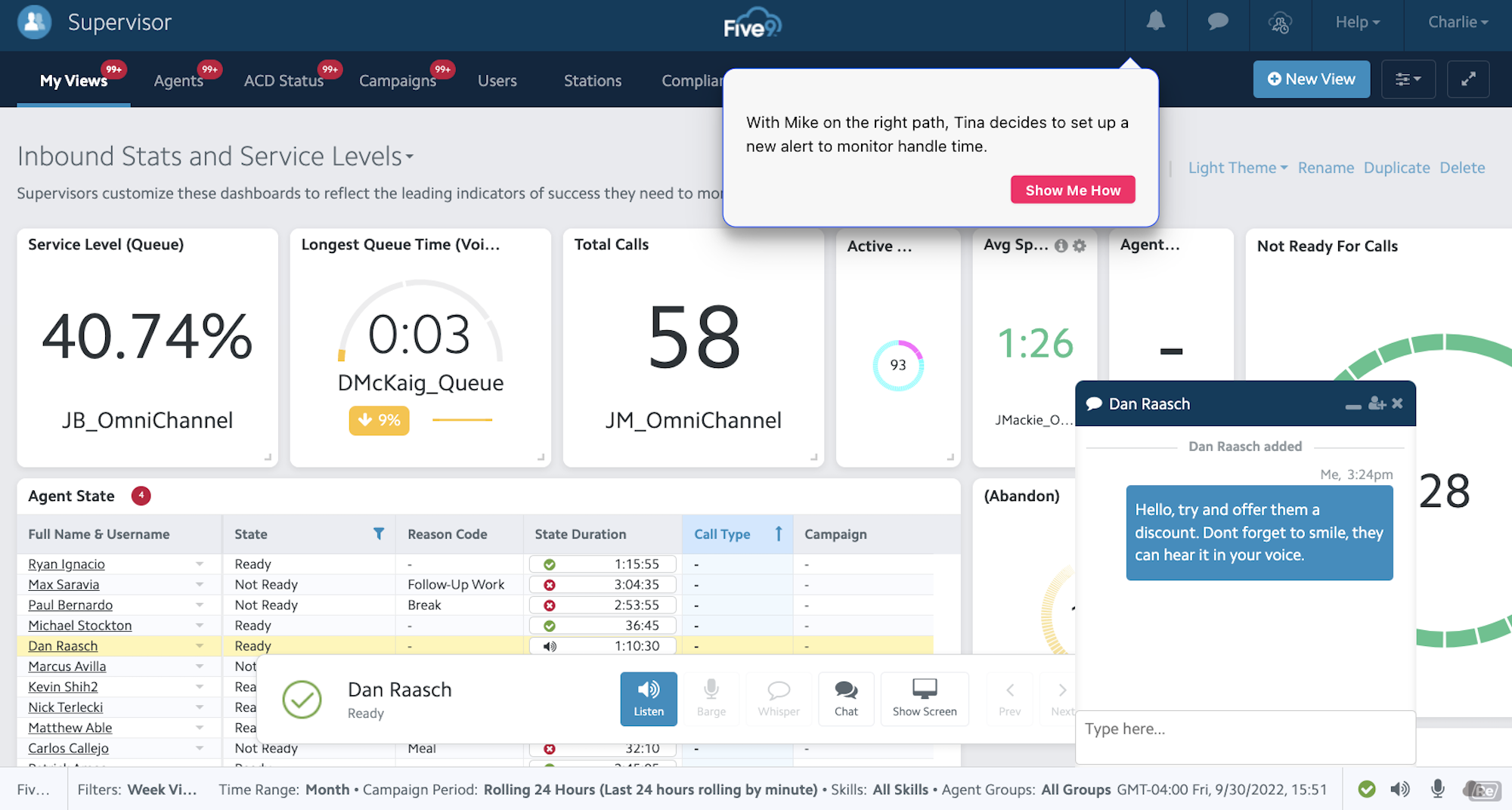
In-call coaching may include real-time call transcription, agent performance scoring, customer sentiment analysis, and CSAT scoring. In-call coaching is best for training newer agents, providing immediate support to struggling agents, and monitoring more experienced agents as a part of the Quality Assurance process.
Post-Call Coaching
Often used in conjunction with in-call coaching, post-call coaching refers to the agent coaching and training that takes place after a call has ended. Post-call coaching is more detailed and provides individualized agent feedback based on the entire interaction–including performance scores, customer survey responses, call outcomes, and fluctuations in KPIs.

Agents can receive one-on-one coaching from supervisors, be assigned specific training modules to improve certain aspects of their performance, be assigned a peer mentor, or review scoresheet breakdowns to conduct a self-assessment. Because post-call coaching is time-consuming and usually includes 1:1 contact center coaching from a peer or supervisor, it’s best for smaller call centers that need to upskill existing agents instead of hiring new ones.
Product and Service Training
New agents will receive product and service training as a part of the onboarding process–but continued product and service coaching helps maintain a consistent and up-to-date customer experience. Product and service coaching can take place in a classroom, on the job, via video conferencing, or through self-guided online courses that allow remote agents to go at their own pace. In most cases, product and service training is a group activity, allowing for peer coaching and collaboration alongside supervisor instruction.
AI-Powered Coaching and Simulations
AI coaching simulators provide zero-risk role-play scenarios that let agents develop and improve their skill sets by interacting with human-like bots.
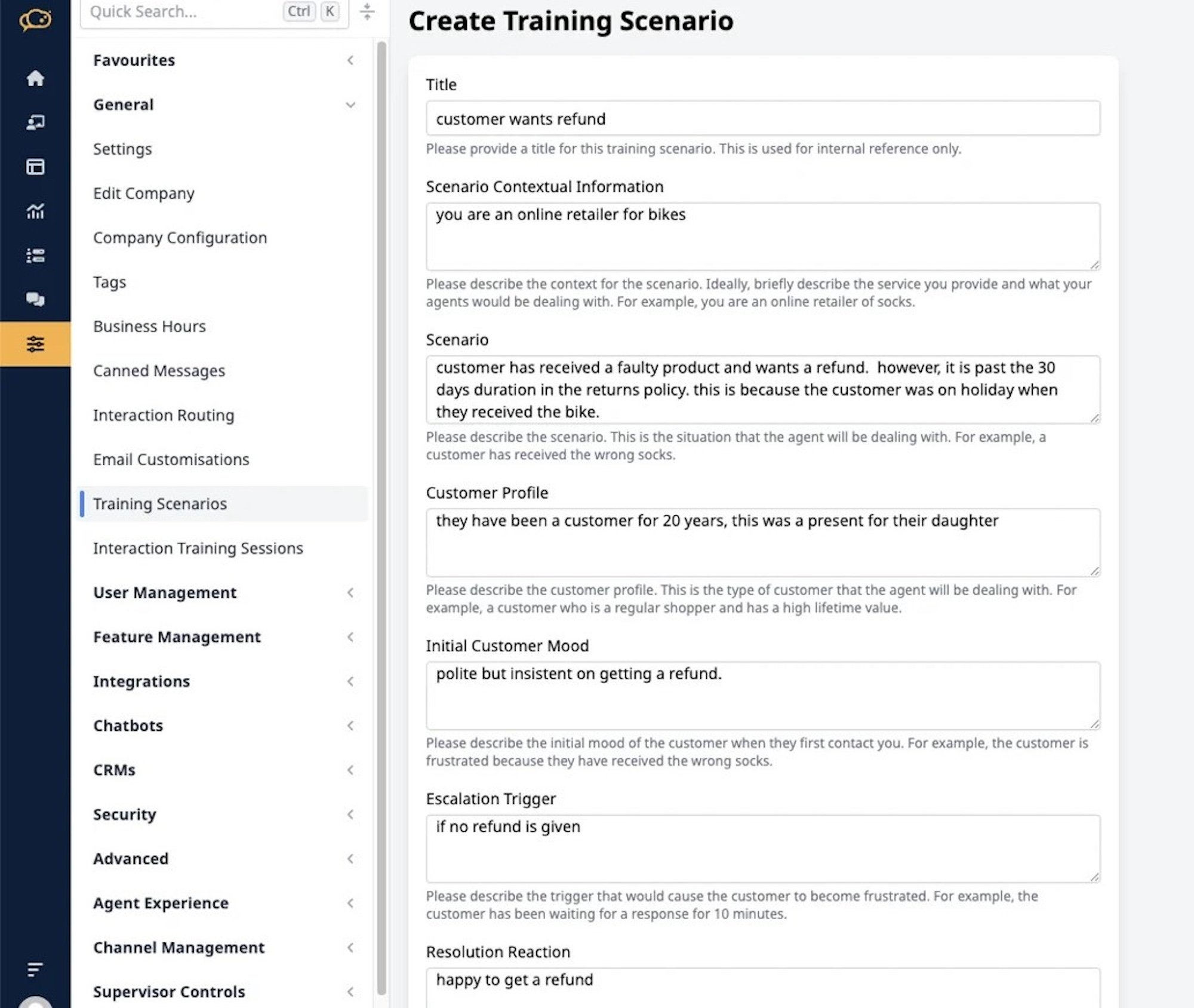
These AI coaching tools can ask agents questions, take on different emotions, test agent product knowledge, make various sales and service requests, and provide instant performance feedback. AI-powered customer conversation simulations can increase CSAT scores by up to 50% and help agents achieve 70% faster speed-to-proficiency–making them an ideal fit for enterprise contact centers or teams with limited resources to dedicate to agent coaching.[*]
Soft Skill Training
87% of consumers say an agent’s tone of voice is the most important part of the customer communication experience–meaning soft skills like empathy, active listening, and adaptability are essential aspects of the call center coaching process.[*] These skills improve an agent’s phone etiquette, help with emotional regulation when dealing with difficult customers, and increase consumer trust. If agent attrition is high, CSAT scores are low, and agents are burned out from abusive customers, soft skill coaching can help.
Measuring the ROI of Call Center Coaching
Coaching is not just a feel-good exercise for team morale, it's the lifeblood of a proactive and well-run call center. The best way to prove coaching works? Track the right metrics. By keeping an eye on key performance indicators (KPIs) like call times, customer satisfaction, and agent retention, you can see exactly how coaching moves the needle and where to fine-tune your approach.
Shorter Call Times (AHT)
Nobody likes being stuck on a long call: not customers, not agents. Good coaching sharpens problem-solving skills and product knowledge, so agents handle issues faster without rushing. The result? Reduced Average Handle Time (AHT), which cuts operational costs and leaves customers feeling heard, not hurried.
Fewer Repeat Calls (FCR)
When agents get coached on active listening and troubleshooting, they solve problems right the first time. Higher First Call Resolution (FCR) means fewer repeat calls, shorter wait times, and customers who don’t have to keep explaining their issue. Another plus is that your team spends less time cleaning up unresolved cases and more time tackling new issues.
Better Customer Feedback (CSAT)
Customers remember how you make them feel. Coaching helps agents master communication, empathy, and quick thinking, these are skills that turn frustrating interactions into positive ones. Over time, that shows up in higher Customer Satisfaction (CSAT) scores and more loyal customers.
Fewer Agents Quitting
Let’s be real: high turnover is costing your operation time and money. But when agents get consistent, supportive coaching, they feel more confident and valued, which means they stick around longer. Lower attrition saves you the headache (and cost) of constantly hiring and retraining.
More Sales Closed
For sales teams, coaching is a revenue booster. Role-playing objections, refining pitches, and building rapport turn hesitant agents into closers. The payoff? Higher conversion rates, bigger upsells, and a clear link between coaching and your bottom line.
Fortifying A Team That’s All-In
Agents who get real coaching, not just criticism, feel like their growth matters. That leads to higher engagement, sharper skills, and a team that wants to deliver great service. And when your people thrive, so does your call center.
Common Challenges with Call Center Coaching
Call center coaching comes with a fair share of challenges, but combining the right technology with creative problem-solving can eliminate or reduce most of them. Being aware of some of the top call center coaching challenges is the first step–but don’t worry, we provide solutions to all these problems and more in the best practices section of this post.
Inconsistent Coaching
Outdated training materials and knowledge bases, conflicting feedback from different managers, and the failure to develop clear customer communication guidelines spell disaster for your call center. Frequently review and update training materials, ensure knowledge base articles and agent call scripts have a consistent brand voice, and eliminate communication silos between managers.
Infrequent Coaching
Too often, call centers take a “one-and-done” approach to employee training. Inexperienced call center managers place all their focus on a lengthy (and exhausting) onboarding process at the expense of continuing education and daily micro-coaching.
The truth is that agents require about 4 coaching sessions before they fully implement a new skill–and the first coaching session is rarely effective.[*] Automated post-call performance scores and AI Agent Assist monitor 100% of interactions and provide instant, daily feedback without the time commitment of 1:1 live coaching.
High Agent Turnover
Given that call centers already have an incredibly high turnover rate, it can be difficult to justify the time and financial investment that successful call center coaching requires. You may invest hundreds of hours (and thousands of dollars) coaching an agent, only to have them suddenly quit.
While the stress of working in a call center means your agent turnover rate may never be as low as you want it to be, there are things you can do to increase agent retention and boost employee engagement. Frequently collect anonymous employee feedback, implement agent recognition and rewards programs, gamify performance management, and optimize agent schedules and soft skill training to prevent burnout.
Increased Call Volume
Especially in smaller call centers, an unexpected increase in call volume leaves little time for extended coaching. Even if call volumes are steady, it’s still hard to find enough time for 30-minute 1:1 coaching sessions with managers or peers–especially given that it takes 10-14 hours of coaching for an agent to fully develop a new skill.
Creating coaching materials like scoresheets, knowledge bases, and training modules can take up to 5 times as long as the actual coaching process.[*] While GenAI automatically creates knowledge base content and AI-powered feedback eliminates the need for extensive 1:1 coaching, finding enough time for effective coaching remains a challenge.
Best Practices for Call Center Coaching
Best practices for effective call center coaching include:
Use Call Monitoring and Recording
Call monitoring tools let managers listen in on real-time interactions between customers and agents without either party’s knowledge. If needed, managers can use call whisper to coach agents without the customer hearing them, or instant message agents with coaching advice.

Call recording and transcription tools let managers review customer-agent conversations at any time. Admins can use call recordings to create a “best practices playlist” of excellent customer interactions, ideal for continued coaching and agent onboarding.
Create Agent Scorecards
Customizable or template-based scorecards are a standardized way to evaluate individual agent performance and identify areas for improvement. Admins can create questions, add one or more acceptable answers, assign different point values, and add trigger words/phrases for automated scoring.
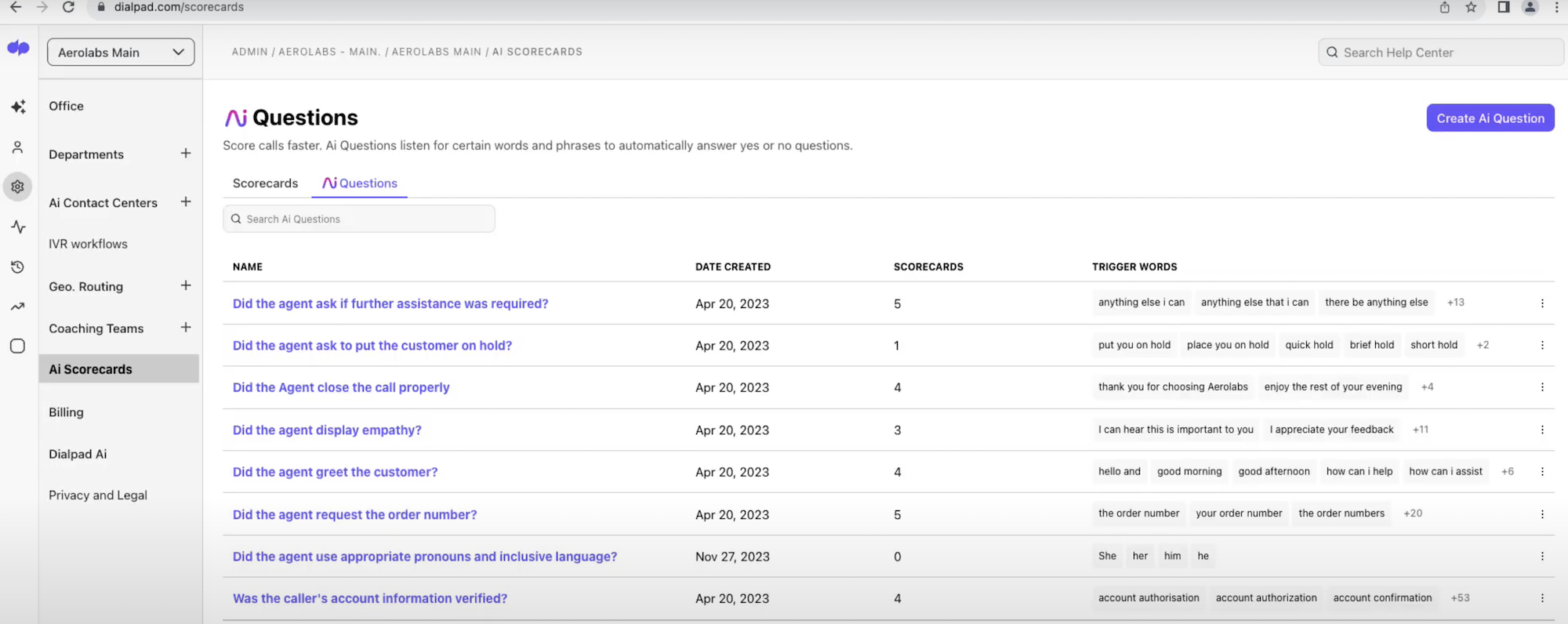
Most scorecards function as a kind of checklist to ensure that agents follow service and support interaction guidelines. Agents can instantly review their scorecards once an interaction is complete, and admins can receive real-time alerts when an agent’s score drops below a certain level. Based on the agent’s grade/score, admins can automatically assign the agent relevant training modules--and block them from accepting new customer conversations until they’ve completed their assignments.
Automate Coaching With AI Agent Assist
Agent Assist tools integrate with your internal knowledge base and CRM tools to provide automated next-best action suggestions to agents during live customer conversations.

Agent Assist uses machine learning, Natural Language Processing, and customer sentiment/intent analysis to make context-best suggestions, and agents don’t lose time manually searching for data. AI Assist empowers contact center agents, eliminates excessive customer follow-ups, and provides automated in-call training sessions.
Gamify Coaching and Quality Management
Gamifying performance evaluation and coaching processes increases agent engagement, boosts productivity levels, highlights top performers, and makes agent training fun. Call center gamification tools set clear benchmarks for success, reinforce essential coaching concepts, and help agents determine and develop their skill sets. Admins can create individual or team-based challenges, enable real-time performance wallboards, and display leaderboards to the entire office for a sense of friendly competition.

Gamification makes it easy to recognize and reward your best agents–a key to increased agent retention, given that 31% of agents feel undervalued and unappreciated at work.[*]
Send Out Customer and Agent Surveys
66% of call center leaders say combining post-call customer surveys with QA monitoring is the most effective way to improve CSAT scores.[*] Results from customer surveys highlight gaps in employee training, and can be shared directly with agents for more individualized feedback. Agent surveys are just as valuable, allowing team members to share their feedback about existing training materials and your call center’s coaching process. Agents can offer suggestions about how to improve the coaching process, bring your attention to unrealistic standards or KPI goals, and let you know which topics they’re still struggling to grasp.
Set Clear Performance Monitoring KPIs
While agent scorecards and customer surveys give call center managers deep insight into agent performance and highlight coaching opportunities, live and historical KPI monitoring is equally essential. Admins can set up real-time KPI alerts when agent performance drops below a certain threshold to optimize in-call coaching techniques. Monitoring specific metrics helps you set clear performance goals, monitor agent progress over time, and evaluate the effectiveness of your current coaching strategy. Popular call center quality management KPIs include first call resolution, average handle time, call transfer rate, and CSAT/NPS scores.
Leverage Conversational Analytics
Although standard KPIs are a helpful tool for evaluating agent performance and optimizing coaching strategies, quantitative analytics only tell part of the story. Unlike random conversation sampling, conversational analytics monitor 100% of calls and recording transcriptions. That’s why 54% of contact center leaders say speech analytics is a useful tool for automating coaching scorecards–and 51% leverage speech analytics to provide key coaching insights.[*]
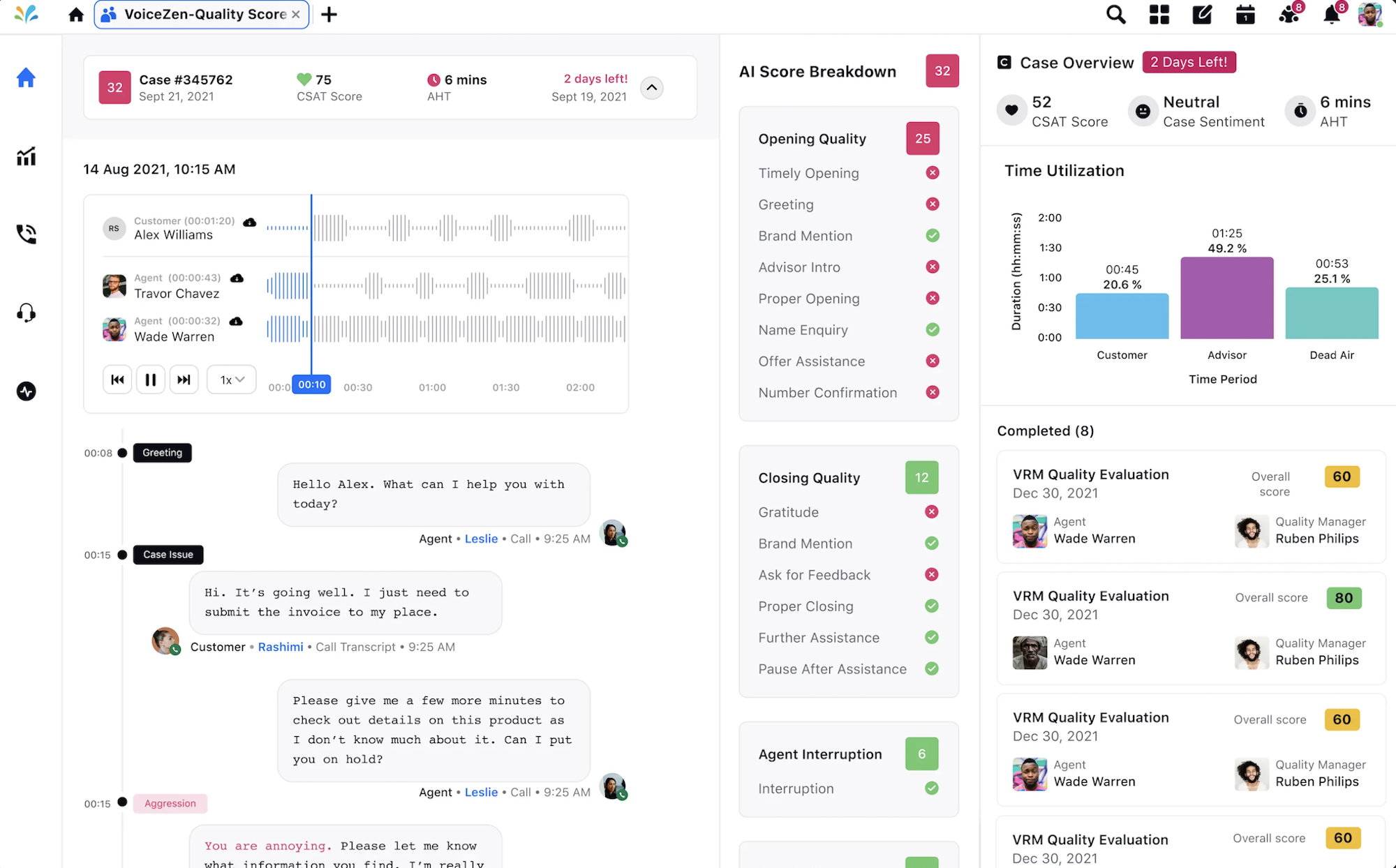
Speech and text analytics leverage customer sentiment analysis and emotion detection to evaluate agent performance and soft skills, identify common problems and support topics, and even monitor how often agents use filler words like “um.” Some conversational analytics tools include silence and overtalk detection to evaluate interaction flow, while others track coaching effectiveness, monitor how much an agent’s performance has improved over time, and track agent progression through assigned coaching materials. Admins can filter analytics by call type, individual agent, date range, support topic, department, and more.
Embrace Microlearning
Instead of hosting days-long training seminars and hours-long coaching sessions, keep performance feedback short and sweet with microlearning. Microlearning coaching sessions are highly targeted, address only one topic at a time, and last between 3-5 minutes. Microlearning increases retention rates by 25-60% and can cut agent training and development costs by up to 50%.[*] Microlearning helps admins create clear action plans and keeps training schedules achievable and realistic, reducing agent burnout.
Best Call Center Coaching Tools for Real Results
The right tools transform your coaching program from passable to game-changing. The right toolkit should be helping you track performance, deliver actionable feedback, and provide targeted training efficiently. From AI-powered insights to bite-sized learning, these solutions help build a data-driven coaching strategy that improves both agent performance and customer experience.
AI Coaching Tools
AI-powered tools analyze calls to provide instant feedback and uncover coaching opportunities. By evaluating speech patterns, sentiment, and conversation flow, these platforms help supervisors deliver precise, timely guidance.
Key Features
- Real-time agent guidance: Flags issues like missed compliance steps or rushed responses during live calls
- Speech and sentiment analytics: Detects customer frustration and agent tone for deeper insights
- Automated coaching recommendations: Suggests targeted training based on call trends
QA Scorecard Platforms
Quality assurance platforms standardize performance reviews with structured scorecards, ensuring fair and data-backed assessments. Integrated dashboards help track progress and identify coaching priorities.
Key Features
- Customizable scorecards: Align evaluations with specific business goals (e.g., sales, support, compliance)
- Performance trend tracking: Highlights strengths and recurring weaknesses across the team
- Automated coaching workflows: Triggers follow-up training when scores indicate skill gaps
Microlearning Platforms
Short, focused training modules help agents quickly absorb and apply new skills without disrupting workflow. These platforms reinforce coaching concepts through interactive, on-demand lessons.
Key Features
- Bite-sized but engaging lessons: 5-10 minute videos, quizzes, and scenario-based exercises
- Personalized learning paths: Recommends modules based on individual performance gaps
- Progress and completion tracking: Ensures accountability and measures engagement
Feedback & Survey Tools
Collecting feedback from both customers and agents ensures coaching strategies address real needs. These tools help refine training based on actual pain points and successes.
Key Features
- Post-call customer surveys: Measures CSAT and identifies recurring service issues
- Agent feedback collection: Gauges coaching effectiveness and engagement levels
- Real-time reporting: Tracks trends to adjust coaching strategies proactively
Effective call center coaching is not a luxury at all: it's your competitive edge. By combining structured strategies with the right tools, you create the ultimate win-win scenario: agents grow their skills with targeted support, while customers get consistently exceptional service. Remember, the best call center coaching programs balance real-time guidance with ongoing development, measure what matters (from AHT to agent morale), and adapt as needs evolve. Whether you're refining existing call center coaching or building from scratch, focus on clarity, consistency, and connection because when your team thrives, so does your entire operation.
FAQs
Below, we’ve answered the top call center coaching FAQs.

